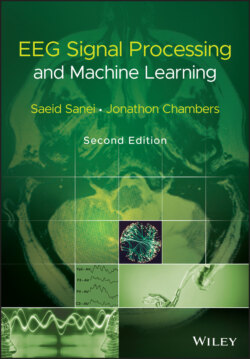Читать книгу EEG Signal Processing and Machine Learning - Saeid Sanei - Страница 70
4.5.1.3 Discrete‐Time Wavelet Transform
ОглавлениеIn order to process digital signals a discrete approximation of the wavelet coefficients is required. The discrete wavelet transform (DWT) can be derived in accordance with the sampling theorem if we process a frequency band‐limited signal.
The continuous form of the WT may be discretized with some simple considerations on the modification of the wavelet pattern by dilation. Since generally the wavelet function is not band limited, it is necessary to suppress the values outside the frequency components above half the sampling frequency to avoid aliasing (overlapping in frequency) effects.
Figure 4.5 Morlet's wavelet: real and imaginary parts shown respectively in (a) and (b).
Figure 4.6 Mexican hat wavelet.
A Fourier space may be used to compute the transform scale‐by‐scale. The number of elements for a scale can be reduced if the frequency bandwidth is also reduced. This requires a band‐limited wavelet. The decomposition proposed by Littlewood and Paley [21] provides a very nice illustration of the reduction of elements scale‐by‐scale. This decomposition is based on an iterative dichotomy of the frequency band. The associated wavelet is well localized in Fourier space where it allows a reasonable analysis to be made although not in the original space. The search for a discrete transform, which is well localized in both spaces leads to multiresolution analysis.
